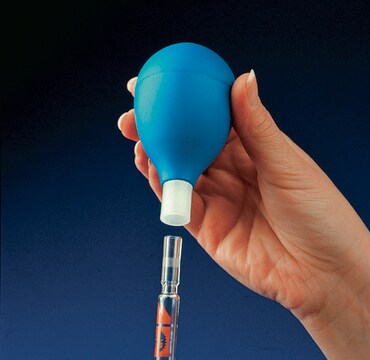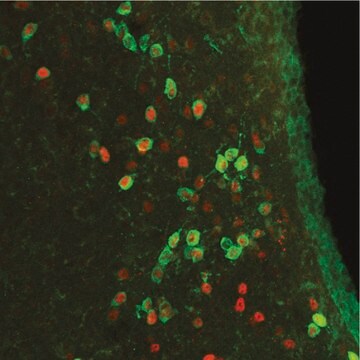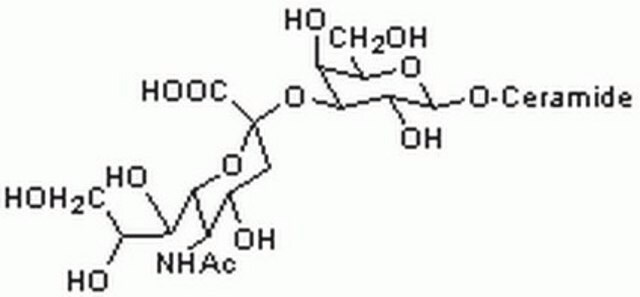MABC1112
Anti-Diasialoganglioside GD3 Antibody, clone R24
clone R24, from mouse
Sinonimo/i:
GD3, Ganglioside GD3, Disialoganglioside GD3
About This Item
Prodotti consigliati
Origine biologica
mouse
Livello qualitativo
Forma dell’anticorpo
purified antibody
Tipo di anticorpo
primary antibodies
Clone
R24, monoclonal
Reattività contro le specie
human, mouse, rat
tecniche
affinity binding assay: suitable
flow cytometry: suitable
immunohistochemistry (formalin-fixed, paraffin-embedded sections): suitable
immunoprecipitation (IP): suitable
western blot: suitable
Isotipo
IgG3κ
Condizioni di spedizione
ambient
modifica post-traduzionali bersaglio
unmodified
Informazioni sul gene
human ... ST8SIA1(6489)
Descrizione generale
Specificità
Immunogeno
Applicazioni
Affinity Binding Assay: A representative lot reacted with heat stable glycolipid on the surface of all SK-MEL melanoma and two of the five astrocytoma cells tested, whereas epithelial cell types, fibroblasts, and cells of hematopoietic origin were found to lack the surface antigen recognized by clone R24 (Dippold, W.G., et al. (1980). Proc. Natl. Acad. Sci. U.S.A. 77(10):6114-6118).
Flow Cytometry Analysis: A representative lot immunostained the surface of cultured primary rat cerebellar cells (Kasahara, K., et al. (1997). J. Biol. Chem. 272(47):29947-29953).
Immunocytochemistry Analysis: A representative lot immunostained NGF-induced nurite outgrowths of cultured DRG neurons from wild-type, but not GD3 synthase-knockout, mice (Ribeiro-Resende, V.T., et al. (2014). PLoS One. 9(10):e108919).
Immunohistochemistry Analysis: A representative lot detected GD3 immunoreactivity in unfixed frozen tissue samples of primary melanoma and metastatic malignant melanoma (Dippold, W.G., et al. (1985). Cancer Res. 45(8):3699-3705).
Immunoprecipitation Analysis: A representative lot co-immunoprecipitated Lyn from rat brain membrane extract. Clone R24 co-immunoprecipitated caveolin and the exogenously expressed Lyn, but not Src, from CHO cells expressing exogenous GD3 synthase (Kasahara, K., et al. (1997). J. Biol. Chem. 272(47):29947-29953).
Apoptosis & Cancer
Qualità
Flow Cytometry Analysis: 0.2 µL of this antibody detected GD3 immunoreactivity on the surface of one million SK-MEL-28 human skin melanoma cells.
Stato fisico
Stoccaggio e stabilità
Handling Recommendations: Upon receipt and prior to removing the cap, centrifuge the vial and gently mix the solution. Aliquot into microcentrifuge tubes and store at -20°C. Avoid repeated freeze/thaw cycles, which may damage IgG and affect product performance.
Altre note
Esclusione di responsabilità
Non trovi il prodotto giusto?
Prova il nostro Motore di ricerca dei prodotti.
Codice della classe di stoccaggio
12 - Non Combustible Liquids
Classe di pericolosità dell'acqua (WGK)
WGK 2
Punto d’infiammabilità (°F)
Not applicable
Punto d’infiammabilità (°C)
Not applicable
Certificati d'analisi (COA)
Cerca il Certificati d'analisi (COA) digitando il numero di lotto/batch corrispondente. I numeri di lotto o di batch sono stampati sull'etichetta dei prodotti dopo la parola ‘Lotto’ o ‘Batch’.
Possiedi già questo prodotto?
I documenti relativi ai prodotti acquistati recentemente sono disponibili nell’Archivio dei documenti.
Il team dei nostri ricercatori vanta grande esperienza in tutte le aree della ricerca quali Life Science, scienza dei materiali, sintesi chimica, cromatografia, discipline analitiche, ecc..
Contatta l'Assistenza Tecnica.







